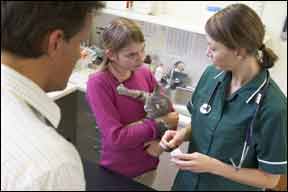Trying to adjust your cat’s diet because of a serious medical condition is undoubtedly a good idea. But experts insist that there is a right way and a wrong way to go about it. Some problems may respond readily to a dietary adjustment, while other problems can be more vexing and require treatment aside from nutritional changes.

288
Firstly, remember that therapeutic diets do not cure diseases. They can alleviate clinical abnormalities on a temporary basis, and alleviating these abnormalities can certainly help our beloved pets feel better and give them a higher quality of life.
Most Common Diseases. Dietary management is capable of slowing the progression of certain diseases. Here is an overview of some of the serious diseases and the dietary adjustments that can help them.
Renal disease involves the inability of the kidneys to perform normal functions of eliminating waste products and can be accompanied by the danger of significant bone disease. A diet to deal with these problems should generally include somewhat reduced levels of (but higher-quality) protein; reduced salt and phosphorus; and increased caloric density.
Heart disease generally calls for a diet low in sodium, accompanied by high-quality protein and increased caloric density.
Diabetes is characterized by significant glucose intolerance and an absolute or relative lack of insulin. Unfortunately, it poses a special nutritional challenge. In general, a ration that provides a slow-release form of energy and a higher level of fiber has been shown to be of some value.
Allergies, especially those that cause gastrointestinal problems, may be ameliorated with dietary adjustments. The cat owner and veterinarian first must determine what ingredient your cat is allergic to in its current diet — beef, chicken, corn, etc. The goal is to keep the diet nutritionally stable while replacing the troublesome ingredient. Historically, a lamb and rice diet often was effective, but it has become less so since this diet became more popular in the pet food market. Experiment with fish, venison, rabbit or other novel protein source under your veterinarian’s guidance. When you find one that works, stick with it.
Cats have historically been prone to the developing of urinary tract stones, or uroliths. This may involve one of several conditions. Magnesium-based crystals have at times been virtually epidemic, particularly among male cats. Reducing the magnesium in the diet and adjusting the diet to create an acidic urine can prevent these struvite (magnesium-ammonium-phosphate) crystals from forming.
However, the incidence of other types of stones have increased — and this requires an almost opposite approach. Calcium oxalate stones may respond to medical therapy, but there is no reliable diet that alone can prevent the problem.
Hepatobiliary problems are liver-related diseases. They pose a special problem because nutritional adjustments remain difficult to determine among experts.
Talk to An Expert. Obviously, you need to have a thorough veterinary examination performed if you suspect your cat is harboring a health problem; and a prescription diet should be fed only upon your veterinarian’s recommendation. Many of these special diets are available through a veterinarian’s office.
One challenge that can present itself is if you’re living in a multicat home: You probably don’t want all your cats eating the same prescription food! One thing to try is to set up feeding stations — separate areas set aside just for feline mealtimes. Some cats prefer to eat on the ground, while others may be more content to eat on an elevated surface. You may even have to serve meals in separate, closed-off rooms to make sure the prescription food is being put to good use.



